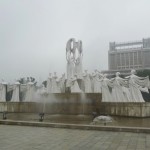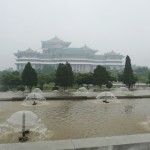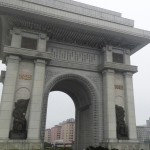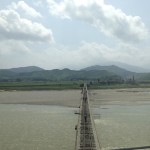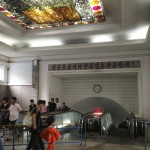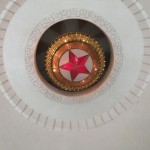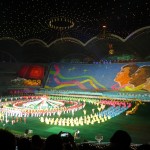Day 3: A packed day on the North Korea tour to Mansudae Fountain Park, Mansudae Grand Monument with the bronze Kim statues, the mountainous Myohyangsan, the laughable International Friendship Exhibition, Pohyonsa the Buddhist temple, Kim Il Sung’s Birthplace, the Pyongyang Metro, the Friendship Tower, and watching the Arirang Mass Games. Phew.
We had a frantic start in the morning, as we did not receive the requested wake up call and were running late… After a quick shower, we assembled in the banquet room for a buffet style breakfast. There was bread, rice, a squid dish, a vegetable dish, chicken and porridge. The drink selection consisted of milk (from a kettle), water, and some sweet sparkling drink.
Once everyone was boarded on the blue bus, we left a bit behind schedule. Our bright and cheerful guides introduced the first stop of the day.
Mansudae Fountain Park
Our bus parked on the side of the empty road and we were told we could take 10 minutes for pictures and to buy flowers to lay at the memorial.
There was a single lady in traditional dress, who sold the flowers, seemingly waiting for us.
It was still quite foggy and the locals we saw were walking to work. The white fountain was on and Behind the fountain was the Grand People’s Study House and next to it was the Mansudae Art Theatre.
After exploring the area, which was empty besides tourists, a few of us walked into the nearby square to get a glimpse of the locals. There was a large mural for Kim Il Sung and Kim Jong-il near the subway entrance. Everyone stared at us as we stood there taking pictures. Our guides eventually called us back to leave.
Mansudae Grand Monument
A short drive up the hill, we parked in a lot with quite a few buses. We were going to pay homage to the Supreme Leaders, in the form of two giant bronze statues.
Our guides warned us that this area is very sensitive and we should be respectful throughout the visit. We were to walk in two lines and not smile or make any gestures while taking pictures with the statues.
There was a group of businessmen and women ahead of us and then it was our turn. We walked to the staircase and lined up in a row. Once the other group exited, we walked in formation to the base of the statues. On cue, Christina and others walked to the wall to lay flowers at their feet.
When they returned to the formation, we all bowed together before returning to the second set of steps where we were allowed to take pictures. Two officials near the statues watched us closely.
The smiling optimistic statues of Kim Il Sung and Kim Jung-il were flanked by communist monuments showing soldiers and workers working together to advance!
Around the corner and took pics of Chollima Statue which looked like a guy riding a horse towards the heavens.
The whole time, a camera man from the tour was following us and filming all our movements. This was of course for the tourist video… of course.
Back to the parking lot, we could use a bathroom with no running water, before boarding the bus.
Our trip took us out of Pyongyang and into the mountains.
On the Road History Lesson
The tour guide gave us an in-depth introduction of North Korea and Pyongyang in excellent Chinese. I smirked when they referred to the Japanese or Americans as “devils” in a matter-of-fact historical summary. China was referred to as the “big brother”.
Some interesting notes according to our guide:
- Citizens don’t have to pay for health insurance, housing, or schooling. (“What China makes the most money”, one tourist joked.)
- Government assigns your home, land, income, occupation, etc.
- Important people/military/celebrities are assigned nice apartments downtown and sports cars.
- Citizens pay 3% of their wages for water and heating.
- Families are strongly encouraged to have babies and are given “prizes” from government when they achieve a certain number (e.g. A gold or silver for two or three kids and the jackpot, a two-story house with an onsite nurse and doctor if you can squeeze out four kids.)
We were soon in the green countryside. The tour guide mentioned earlier that we may have to walk across a bridge which we didn’t really understand… until we saw the bridge. Due to the storm, a part of the bridge was swallowed by the river. In our lane the supports were damaged causing the road to crack and buckled.
Our fully loaded tour bus drove right over it while locals watched in amazement.
The guide said that future tours will not be going via this route.
Myohyangsan
We eventually drove over another bridge and arrived at a reasonably well developed traditional town. Young students walked home and soldiers lounged about.
Our bus along with another tour bus drove through the town and continued into the mountain. We drove by the seemingly vacant Hyangsan Hotel, the third best hotel in North Korea.
Passing a military checkpoint, our bus pulled into a parking space and we arrived at our next attraction.
International Friendship Exhibition
The museum showcased all the gifts given to the leaders Kim Il Sung and Kim Jung-il. The entrance was guarded by soldiers with chrome AK-47s.
A Korean speaking tour-guide in traditional dress introduced the museum as our guide translated. We were then escorted inside through the large heavy metal doors.
There was a strict no picture policy, so we had to check in our bags, phones, and cameras. We were issued shoe covers to put on before going through a metal detector and a pat-down.
The guides allowed for a quick break for the restrooms before the tour started.
On entering the first room, there is a world map with dots on each capital of a country that has given a gift and a counter that read 110,000, representing all the gifts given. The items on display seemed to be the “best of” with a Chinese screen from China President Xi Jinping, a silver bowl from ex-US Secretary of State Madeleine Albright and many other random gifts.
Our group moved from room to room, as the guide pointed out certain important items. What was interesting was that the gifts were not just from governments but also from companies, organizations, and individuals. For example, the Socialist Party of Australia gave a vase.
The rooms were categorized by country. China and Russia had large sections and most gifts seemed to come from Communist countries or groups. There were guns from Angola, Mongolia, and Cambodia, a golden tank model with “power king” etched on the side from a Chinese factory, paintings and photographs, and even bear and tiger skins.
The building for some reason had over 200 rooms, all walled with marble and in excellent condition.
The next room was different. The escort’s smile disappeared as we were told to button our jackets and stand up straight. Then we lined up in three rows and entered a room with a wax statue of Kim Il Sung.
Again, we stood in three rows and bowed to the statue, which we were told was made in China.
This process was repeated in another room for Kim Jong Suk, the heroine wife of Kim Il Sung.
Then we took an elevator to the top floor where there was a large balcony with a seating area and a view of the mountains. It was very peaceful and picturesque.
I noticed a work crew under us constructing a new section of the building. Again, they had no machinery or sophisticated tools. Instead of a wheelbarrow or bucket, two men held a wooden board to move a small shovel-full of cement. They climbed up the ramp and dumped it in the mold. This was how they were constructing the floor-high cement wall.
There was also a souvenir shop on the top floor which we quickly browsed before leaving the museum.
Outside we were just in time to see the changing of the guards. Surprisingly our guides didn’t ask us to stop taking pictures as the soldiers marched, wielding their chromed AKs.
The museum was a joke and a waste of resources, though a serious attempt by the government to show that the world supports North Korea.
We returned to the town were we stopped at Chongchon Hotel for lunch, followed by the other tour bus.
The set meal was composed of rice, korean style beef, veggies, fried fish, a soup and a nice dark beer.
Pohyonsa
Our next stop was the nearby Buddhist temple.
Another guide wearing traditional dress greeted us and led us onto the grounds.
We walked through several gates that houses the figures of Buddhist deities. In the main courtyard area there were three prayer halls, pagodas and a garden. We didn’t see any civilians except the Buddhist monks inside the halls.
The tour concluded in a small gift shop, which we came to realize all carry the same souvenirs.
Back on the bus we were off to see the family birthplace.
Kim Il Sung’s Birthplace
A girl in traditional dress guided us through this museum as well. We knew the process well by now.
After a bit of background, we had access to the guarded area that supposedly contained the hut Kim Il Sung was born in.
The basic grass hut had black and white pictures of the leading family hanging on the walls. Legend has it that generations of the family were born in this house.
The area use to be a peasant village until they protected it as a cultural heritage park and relocated the other villagers. Now the surroundings are grassy fields and a single water well.
We hiked five minutes along a path up the mountain, but the view over Pyongyang was severely obscured due to the rain and fog.
Back to the bus, we were returning to the capital. We tried to nap a bit but the thought of bridges collapsing kept us awake. Luckily the supports held up and we made it back downtown.
Pyongyang Metro
Our next visit was a one-stop ride on the metro from Puhung to Yonggwang station. The tour guides seemed a bit stressed trying to herd our large group through the crowds into the metro and down the escalator. There weren’t any turnstiles and just two guards standing watch. We were told not to take pictures of the people, especially military. The system is one of the deepest metros in the world. We went down over 100 meters to the platform.
We really stood out from the crowd and the commuters couldn’t stop staring. The platform was very basic and lit with fluorescent lights. An old train rolling into position and we were instructed to board the first cabin. Strangely, the train didn’t move for a long time, which I think was to make sure our entire group was on board.
On the train, two glowing young children offered their seats to an older couple from our group. Miraculously, they spoke in fluent Mandarin. When asked by the lady how they knew Mandarin, they replied that they study it in school. Coincidence?
When we arrived, we were ushered off and up the stairs. Many people stopped to take pictures of the extravagantly decorated hall.
At the exit, we observed the city life before boarding our bus. This was definitely a highlight of the day.
Friendship Tower
We visited this memorial hall to honor the Chinese that died in the Korean War. The army was based in North Korea for eight years, three for the war and five for rebuilding.
Our group lined up in rows and bowed three times. Some also placed flowers on the memorial.
Inside the memorial were three large wall murals of the struggle and rebuilding. There was also a book with the names of those that died in battle.
All this sightseeing worked up an appetite. Our bus took us to a restaurant and souvenir shop run by our tour company. We sat with our fellow tourists and had egg, vegetables, beef, spicy tofu, rice, spicy soup and beer. The guy next to me got some soju, which he let us try.
Then we headed to the last stop of the day, the mass games. One of the guides gave a brief introduction to the festival and eloquent sang the Arirang song on speaker system. She also mentioned that this was the opening night of the games and handed out the tickets. The show also holds the Guinness Book of World Records for the largest in the world with over 100,000 performers.
Arirang – Mass Games
We arrived at the bustling Rungnado May Day Stadium which stands as the largest stadium in the world in terms of seating capacity at 150,000. Walking up the stairs, we went through a special entrance for foreigners. Near the entrance, there were souvenirs (paintings of the mass games) and refreshments being sold.
Walking into the stadium, the size and sound echoing around the space was stunning. We found our seats. Our guides sat directly behind us and told us not to take pictures of the military section. An attendant went around renting binoculars for 30 RMB, as we waited for the show to start. The stadium filled up but only in the center sections.
The years 1953 and 2013 were on the sides of the stage representing the 60th anniversary of the Korean war armistice.
Across from us in the opposite seating area was a massive display created by students with colored boards. It was really well synchronized. Each student was basically a pixel of a giant screen that generated intricate still and moving pictures.
Then government officials entered and someone made a speech to start the show.
The show was massive in the number of performances and dancers on the stage at the same time. Each synchronized dance told a story. Starting with the Arirang love story, the show progressed with the struggle of Kim Il Sung, a military and armed forces performance, the development of their rockets (quite controversial), and a show for sports like acrobatics and Taekwondo. The last shows were to show the friendship and support from China and Russia, using fat dolls and dragons for China and bear costumes for Russia.
The grand finale filled the stage space with performers and fireworks went off as the North Korean was proudly displayed.
Overall, it was well choreographed though a bit repetitive and lasted about an hour and a half.
Outside, it was difficult to keep up with our group through the massive crowd of people. Back on our bus and some soldiers waved at us and one (male) even blew a kiss… so sweet.
Yanggakdo
Arriving in the hotel, we decided to explore a bit before going to sleep.
We checked out the Pyongyang casino which was tiny and run by a Chinese company. The exchange rates they used were awful, but we played some Blackjack along with some American tourists.
We also browsed the other souvenir shop which sold regular items like underwear and soap. Then we peaked into the Chinese and Korean restaurant.
It was interesting to see a guy who was a part of a film crew talking on a cellphone in the hallway. I’m guessing he had a satellite phone.
Our last stop was the revolving restaurant on the top floor. I noticed that they had a computer which was the first one I saw so far. We were pretty tired and the atmosphere was quite cold and empty, so we left.
Another full day of touring ahead!


